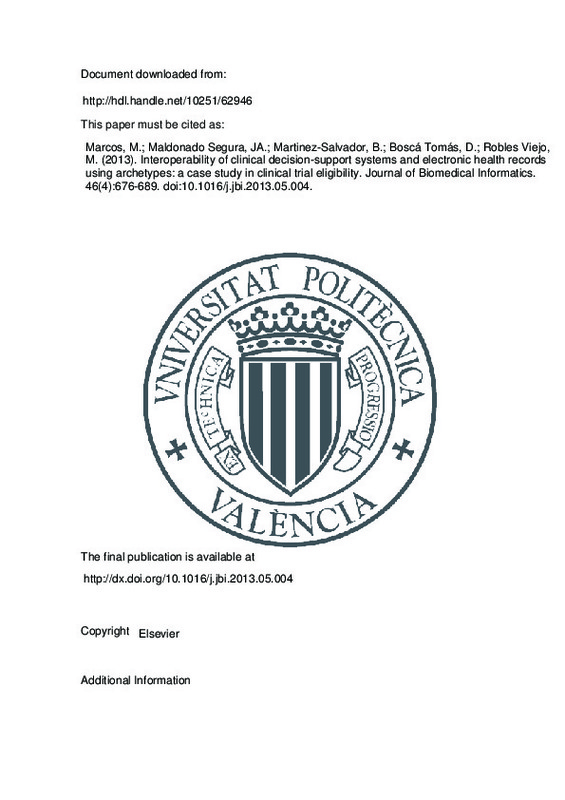|
Resumen:
|
Clinical decision-support systems (CDSSs) comprise systems as diverse as sophisticated platforms to store and manage clinical data, tools to alert clinicians of problematic situations, or decision-making tools to assist ...[+]
Clinical decision-support systems (CDSSs) comprise systems as diverse as sophisticated platforms to store and manage clinical data, tools to alert clinicians of problematic situations, or decision-making tools to assist clinicians. Irrespective of the kind of decision-support task CDSSs should be smoothly integrated within the clinical information system, interacting with other components, in particular with the electronic health record (EHR). However, despite decades of developments, most CDSSs lack interoperability features. We deal with the interoperability problem of CDSSs and EHRs by exploiting the dual-model methodology. This methodology distinguishes a reference model and archetypes. A reference model is represented by a stable and small object-oriented model that describes the generic properties of health record information. For their part, archetypes are reusable and domain-specific definitions of clinical concepts in the form of structured and constrained combinations of the entities of the reference model. We rely on archetypes to make the CDSS compatible with EHRs from different institutions. Concretely, we use archetypes for modelling the clinical concepts that the CDSS requires, in conjunction with a series of knowledge-intensive mappings relating the archetypes to the data sources (EHR and/or other archetypes) they depend on. We introduce a comprehensive approach, including a set of tools as well as methodological guidelines, to deal with the interoperability of CDSSs and EHRs based on archetypes. Archetypes are used to build a conceptual layer of the kind of a virtual health record (VHR) over the EHR whose contents need to be integrated and used in the CDSS, associating them with structural and terminology-based semantics. Subsequently, the archetypes are mapped to the EHR by means of an expressive mapping language and specific-purpose tools. We also describe a case study where the tools and methodology have been employed in a CDSS to support patient recruitment in the framework of a clinical trial for colorectal cancer screening. The utilisation of archetypes not only has proved satisfactory to achieve interoperability between CDSSs and EHRs but also offers various advantages, in particular from a data model perspective. First, the VHR/data models we work with are of a high level of abstraction and can incorporate semantic descriptions. Second, archetypes can potentially deal with different EHR architectures, due to their deliberate independence of the reference model. Third, the archetype instances we obtain are valid instances of the underlying reference model, which would enable e.g. feeding back the EHR with data derived by abstraction mechanisms. Lastly, the medical and technical validity of archetype models would be assured, since in principle clinicians should be the main actors in their development.
[-]
|
|
Agradecimientos:
|
This research has been supported by the Spanish Ministry of Education through Grant PR2010-0279, and by Universitat Jaume I through Project P1182009-38. Additionally, this research has been supported by the Spanish Ministry ...[+]
This research has been supported by the Spanish Ministry of Education through Grant PR2010-0279, and by Universitat Jaume I through Project P1182009-38. Additionally, this research has been supported by the Spanish Ministry of Science and Innovation under Grant TIN2010-21388-C02-01, and by the Spanish Ministry of Economy and Competitiveness under grant PTQ-11-04987.
[-]
|







![[Cerrado]](/themes/UPV/images/candado.png)


